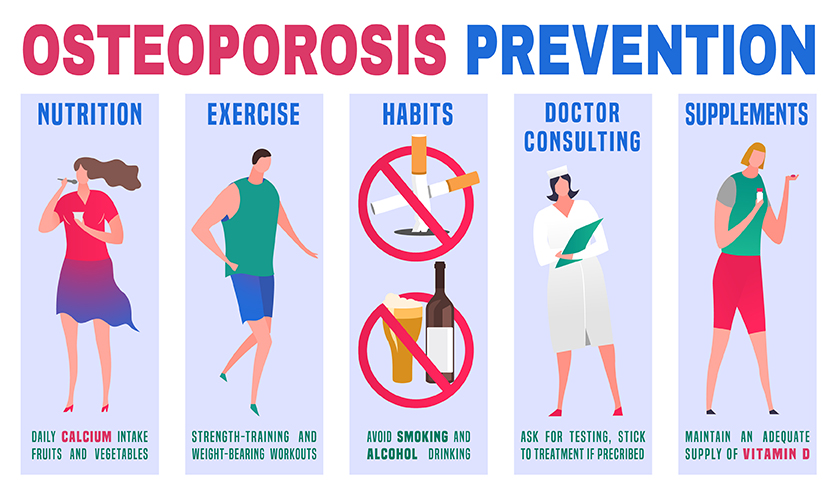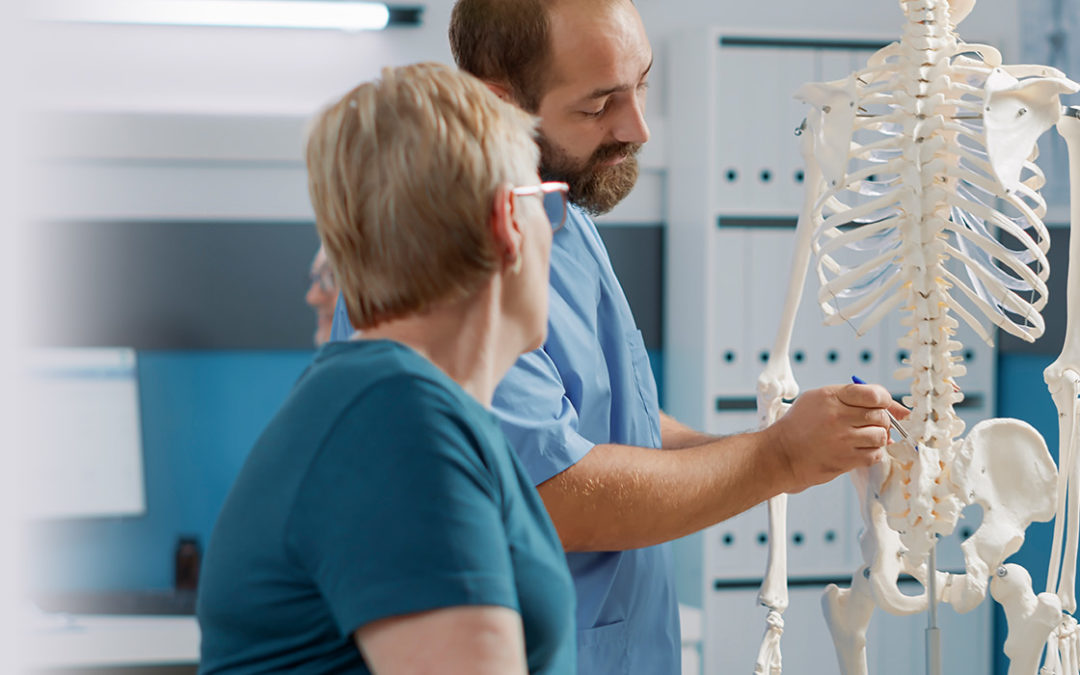WHAT IS OSTEOPOROSIS AND WHAT DOES IT DO?
Osteoporosis is a condition in which bones lose their strength and are more likely to break.
Osteoporosis doesn’t show any outward symptoms and the first sign of osteoporosis is often a broken bone. Broken bones and fractures are the same thing. The bones most fractured as a result of osteoporosis are the wrist, hip, and spine.
Osteoporosis itself is does not cause pain. But broken bones caused by osteoporosis can be painful, and sometimes lead to long-term difficulties. Spinal compression fractures can cause a change in body shape and ongoing, chronic back pain. Hip fractures can result in loss of independence or reduced health and wellbeing. These long-term difficulties can have a big impact on quality of life for those affected.
WHAT CAUSES OSTEOPOROSIS?
After the age of about 35 years, the amount of bone tissue we have naturally starts to decrease. This is often described as ‘bone loss’ or ‘bone thinning’. Our bones don’t look any different from the outside, but the inner structure becomes thinner and sometimes breaks down.
Bone thinning is much more significant as we move into later life, which explains why osteoporosis and broken bones become more common in old age.
While we all lose bone strength as we get older, not everyone will experience broken bones because of osteoporosis. There are many other risk factors that contribute towards low bone strength and our chances of breaking a bone, besides just age.
WHO IS AFFECTED BY OSTEOPOROSIS?
In General, post-menopausal women are most prone to developing osteoporosis and experiencing fractures, although it is possible for men, younger adults and rarely even children to develop the condition too.
EXERCISING WITH OSTEOPOROSIS: STAY ACTIVE THE SAFE WAY
If you have osteoporosis, you might mistakenly think exercise will lead to fracture. In fact, though, using your muscles helps protect your bones.
Osteoporosis is a major cause of disability in older women. A bone-weakening disorder, osteoporosis often results in fractures in the hip and spine — which can severely impair your mobility and independence.
How can you reduce your risk of these life-altering injuries? Exercise can help.
Certain types of exercise strengthen muscles and bones, while other types are designed to improve your balance — which can help prevent falls.
BENEFITS OF EXERCISE
It’s never too late to start exercising. For postmenopausal women, regular physical activity can:
- Increase your muscle strength.
- Improve your balance.
- Decrease your risk of bone fracture.
- Maintain or improve your posture.
- Relieve or decrease pain.
Exercising if you have osteoporosis means finding the safest, most enjoyable activities for you given your overall health and amount of bone loss.
There’s no one- size-fits-all prescription.
BEFORE YOU START
Consult your doctor before starting any exercise program for osteoporosis. You might need some tests first, including:
- Bone density measurement.
- Fitness assessment.
In the meantime, think about what kind of activities you enjoy most. If you choose an exercise you enjoy, you’re more likely to stick with it over time.
CHOOSING THE RIGHT FORM OF EXERCISE
These types of activities are often recommended for people with osteoporosis:
Strength training exercises, especially those for the upper back.
Weight-bearing aerobic activities.
Flexibility exercises.
Stability and balance exercises.
Because of the varying degrees of osteoporosis and the risk of fracture, you might be discouraged from doing certain exercises. Ask your doctor or physical therapist whether you’re at risk of osteoporosis-related problems, and find out what exercises are appropriate for you.
STRENGTH TRAINING
Strength training includes the use of free weights, resistance bands or your own body weight to strengthen all major muscle groups, especially spinal muscles important for posture. Resistance training can also help maintain bone density.
If you use weight machines, take care not to twist your spine while performing exercises or adjusting the machines.
Resistance training should be tailored to your ability and tolerance, especially if you have pain. A physical therapist or personal trainer with experience working with people with osteoporosis can help you develop strength-training routines. Proper form and technique are crucial to prevent injury and get the most from your workout.
WEIGHT-BEARING AEROBIC ACTIVITIES
Weight-bearing aerobic activities involve doing aerobic exercise on your feet, with your bones supporting your weight. Examples include walking, dancing, low-impact aerobics, elliptical training machines, stair climbing and gardening.
These types of exercise work directly on the bones in your legs, hips, and lower spine to slow mineral loss. They also provide cardiovascular benefits, which boost heart and circulatory system health.
It’s important that aerobic activities, as beneficial as they are for your overall health, are not the whole of your exercise program. It’s also important to work on strength, flexibility, and balance.
Swimming and cycling have many benefits, but theydon’t provide the weight-bearing load your bones need to slow mineral loss. However, if you enjoy these activities, do them. Just be sure to also add weight-bearing activity as you’re able.
FLEXIBILITY EXERCISES
Moving your joints through their full range of motion helps you keep your muscles working well. Stretches are best performed after your muscles are warmed up — at the end of your exercise session, for example, or after a 10-minute warm-up. They should be done gently and slowly, without bouncing.
Avoid stretches that flex your spine or cause you to bend at the waist.
Ask your doctor/fitness professional which stretching exercises are best for you.
STABILITY AND BALANCE EXERCISES
Fall prevention is especially important for people with osteoporosis. Stability and balance exercises help your muscles work together in a way that keeps you more stable and less likely to fall. Simple exercises such as standing on one leg or movement-based exercises such as yoga can improve your stability and balance.
MOVEMENTS TO AVOID
If you have osteoporosis, don’t do the following types of exercises:
HIGH-IMPACT EXERCISES
Activities such as jumping, running, or jogging can lead to fractures in weakened bones. Avoid jerky, rapid movements in general. Choose exercises with slow, controlled movements. If you’re generally fit and strong despite having osteoporosis, however, you might be able to engage in somewhat higher-impact exercise than can someone who is frail.
BENDING AND TWISTING
Exercises in which you bend forward at the waist and twist your waist, such as touching your toes or doing sit- ups, can increase your risk of compression fractures in your spine if you have osteoporosis. Other activities that may require you to bend or twist forcefully at the waist are golf, tennis, bowling, and some yoga poses.
If you’re not sure how healthy your bones are, talk to your doctor/fitness professional.
Don’t let fear of fractures keep you from having fun and being active.
KEY TO HELPING OSTEOPOROSIS
- Calcium
- Vitamin D
- Exercise
- Prevent falls
- Maintain a healthy weight
- Stop smoking


